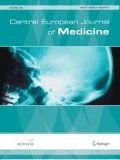Abstract
Background
Contraceptive and sociodemographic risks of repeat induced abortion have not yet been interpreted in Central Eastern Europe.
Methods
A consecutive series of women requesting initial (n=647) or repeat (n=553) artificial abortion were surveyed by means of a questionnaire at a Hungarian university teaching hospital in Szeged, in 2005 and 2006. Self-reported demographic characteristics, attitudes and habits regarding contraceptives were assessed as potential correlates of repeat induced abortion in multivariate logistic regression.
Results
Reliable contraceptive methods were applied slightly less frequently in case of repeat versus first abortion seekers (21.0% vs. 20.1%, P=0.72, [odds ratio (OR) = 1.06, 95% confidence interval (CI): 0.80–1.40]). Adjusted odds ratios (AORs) for undergoing repeat versus first abortion increased significantly with age (1.10, 95% confidence interval [CI] 1.07–1.14), more children (AOR: 2.66, 95% CI: 1.57–4.50), secondary education compared to the tertiary level (AOR: 1.15, 95% CI: 1.08–1.30). A better knowledge of the fertile period of the menstrual cycle was present among women who had had previous abortion (AOR=2.05, 95% CI 1.37–3.05).
Conclusions
Attitude improvement towards modern contraception and promotion of knowledge of correct use of contraceptives among women with reproductive ages may lead to the prevention of recurrent abortion more effectively. EC: emergency contraceptive pill; NS: not significant
Similar content being viewed by others
References
Hungarian Central Statistical Office (2006) Hungarian Demographic Year Book. Hungarian Central Statistical Office, Budapest
Kozinszky Z, Boda K, Bartfai Gy (2001) Determinants of abortion among women undergoing artificial abortion using logistic regression model. Eur J Contr Reprod Health Care 6:145–152
Kamarás F (1999) Fertility and family surveys in countries of the ECE region (Standard country report). United Nations, New York and Geneva
United Nations (2006) Demographic Year Book. United Nations, New York
Millar WJ, Wadhera S, Henshaw SK (1997) Repeat abortions in Canada, 1975-1993. Fam Plann Perspect 29:20–24
Institute AG. Facts in brief: induced abortion in the United States. Available at: http://www.guttmacher.org/pubs/fb_induced_abortion.html
Steinhoff PG, Smith RG, Palmore JA, Diamond M, Chung CS (1979) Women who obtain repeat abortions: a study based on record linkage. Fam Plann Perspect 11:30–38
Berger C, Gold D, Andres D, Gillett P, Kinch R (1984) Repeat abortion: Is it a problem? Fam Plann Perspect 16:70–77
Westfall JM, Kallail KJ (1995). Repeat abortion and use of primary care health services. Fam Plann Perspect 27:162–165
Freeman EW, Rickels K, Huggins GR, Garcia CR, Polin J (1980) Emotional distress patterns among women having first or repeat abortions. Obstet Gynecol 55:630–636
Bajos N, Leridon H, Goulard H, Oustry P, Job-Spira N (2003) Contraception from accessibility to efficiency. Hum Reprod 18:994–999
Glasier A (1998) Safety of emergency contraception. J Am Med Women Assoc 53:219–221
Goulard H, Moreau C, Gilbert F, Job-Spira N, Bajos N (2006) Contraceptive failures and determinants of emergency contraceptive use. Contraception 74:208–213
Grossmann R (2001) Emergency contraception pill can prevent abortion. Am J Public Health 97:1137–1138
Moreau C, Bouyer J, Goulard H, Bajos N (2005) The remaining barriers to the use of emergency contraception: perception of pregnancy risk by women undergoing induced abortions Contraception 71:202–207
Wilcox AJ, Weinberg CR, Baird DD (1995) Timing of sexual intercourse in relation to ovulation. Effects on the probability of conception, survival of the pregnancy, and sex of the baby. N Engl J Med 333:1517–1521
Oddens B (1996) The determinants of contraceptive use. Eburon, The Netherlands
Hosmer DW, Lemeshow S (1989) Applied logistic regression. John Wiley and Sons, New York
Holmgren K (1994) Repeat abortion and contraceptive use. Report from an interview study in Stockholm. Gynecol Obstet Invest 37:254–259
Moreau C, Trussell J, G. Rodriguez, Bajos N, Bouyer J (2007) Contraceptive failure rates in France: results from a population-based survey. Hum Reprod 22:2422–2427
Skjeldestad FE (1994). The incidence of repeat induced abortion -a prospective cohort study. Acta Obstet Gynecol Scand 73:706–710
Garg M, Singh M, Mansour D (2001) Peri-abortion contraceptive care: Can we reduce the incidence of repeat abortions? J Fam Plann Repr H Care 27:77–80
Author information
Authors and Affiliations
Corresponding author
About this article
Cite this article
Kozinszky, Z., Devosa, I., Sikovanyecz, J. et al. Predictive model of repeat induced abortion in Hungary. cent.eur.j.med 6, 701–709 (2011). https://doi.org/10.2478/s11536-011-0080-7
Received:
Accepted:
Published:
Issue Date:
DOI: https://doi.org/10.2478/s11536-011-0080-7




